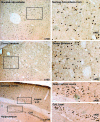Inhibition of cAMP response element-binding protein or dynorphin in the nucleus accumbens produces an antidepressant-like effect
- PMID: 12486182
- PMCID: PMC6758459
- DOI: 10.1523/JNEUROSCI.22-24-10883.2002
Inhibition of cAMP response element-binding protein or dynorphin in the nucleus accumbens produces an antidepressant-like effect
Abstract
The cAMP response element-binding protein (CREB) is a critical integrator of neural plasticity that is responsive in a brain region-specific manner to a variety of environmental and pharmacological stimuli, including widely prescribed antidepressant medications. We developed inducible transgenic lines of mice that express either CREB or a dominant-negative mutant of CREB (mCREB) in forebrain regions and used these mice to determine the functional significance of this transcription factor in the learned helplessness paradigm, a behavioral model of depression. We also use a complementary viral-mediated gene transfer approach to directly test the effect of mCREB in the nucleus accumbens, a brain region important for motivation and reward. The results demonstrate that blockade of CREB by overexpression of mCREB in transgenic mice or by viral expression of mCREB in the nucleus accumbens produces an antidepressant-like effect, whereas overexpression of CREB in transgenic mice results in the opposite phenotype. In addition, mCREB expression was colocalized with and decreased the expression of prodynorphin in nucleus accumbens medium spiny neurons, and antagonism of dynorphin in the nucleus accumbens was sufficient to produce an antidepressant-like effect similar to that observed after blockade of CREB. Together, the results demonstrate that nucleus accumbens CREB-dynorphin influence behavior in the learned helplessness model and suggest that this signaling cascade may contribute to symptoms of depression.
Figures





Similar articles
-
Altered sensitivity to rewarding and aversive drugs in mice with inducible disruption of cAMP response element-binding protein function within the nucleus accumbens.J Neurosci. 2009 Feb 11;29(6):1855-9. doi: 10.1523/JNEUROSCI.5104-08.2009. J Neurosci. 2009. PMID: 19211892 Free PMC article.
-
Altered responsiveness to cocaine and increased immobility in the forced swim test associated with elevated cAMP response element-binding protein expression in nucleus accumbens.J Neurosci. 2001 Sep 15;21(18):7397-403. doi: 10.1523/JNEUROSCI.21-18-07397.2001. J Neurosci. 2001. PMID: 11549750 Free PMC article.
-
Desipramine reduces stress-activated dynorphin expression and CREB phosphorylation in NAc tissue.Mol Pharmacol. 2009 Mar;75(3):704-12. doi: 10.1124/mol.108.051417. Epub 2008 Dec 23. Mol Pharmacol. 2009. PMID: 19106229 Free PMC article.
-
Roles of nucleus accumbens CREB and dynorphin in dysregulation of motivation.Cold Spring Harb Perspect Med. 2013 Feb 1;3(2):a012005. doi: 10.1101/cshperspect.a012005. Cold Spring Harb Perspect Med. 2013. PMID: 23293139 Free PMC article. Review.
-
Kappa-Opioid Antagonists for Psychiatric Disorders: From Bench to Clinical Trials.Depress Anxiety. 2016 Oct;33(10):895-906. doi: 10.1002/da.22500. Depress Anxiety. 2016. PMID: 27699938 Free PMC article. Review.
Cited by
-
Dominant-Negative Attenuation of cAMP-Selective Phosphodiesterase PDE4D Action Affects Learning and Behavior.Int J Mol Sci. 2020 Aug 9;21(16):5704. doi: 10.3390/ijms21165704. Int J Mol Sci. 2020. PMID: 32784895 Free PMC article.
-
Cyclic AMP response element binding protein and brain-derived neurotrophic factor: molecules that modulate our mood?J Biosci. 2006 Sep;31(3):423-34. doi: 10.1007/BF02704114. J Biosci. 2006. PMID: 17006024 Free PMC article. Review.
-
Systemic kappa opioid receptor antagonism accelerates reinforcement learning via augmentation of novelty processing in male mice.Neuropsychopharmacology. 2023 May;48(6):857-868. doi: 10.1038/s41386-023-01547-x. Epub 2023 Feb 17. Neuropsychopharmacology. 2023. PMID: 36804487 Free PMC article.
-
Effects of estrogen treatment on expression of brain-derived neurotrophic factor and cAMP response element-binding protein expression and phosphorylation in rat amygdaloid and hippocampal structures.Neuroendocrinology. 2005;81(5):294-310. doi: 10.1159/000088448. Epub 2005 Sep 21. Neuroendocrinology. 2005. PMID: 16179807 Free PMC article.
-
Kappa opioid receptor antagonism protects working memory performance from mild stress exposure in Rhesus macaques.Neurobiol Stress. 2022 Sep 24;21:100493. doi: 10.1016/j.ynstr.2022.100493. eCollection 2022 Nov. Neurobiol Stress. 2022. PMID: 36532373 Free PMC article.
References
-
- Baamonde A, Dauge V, Ruiz-Gayo M, Fulga IG, Turcaud S, Fournie-Zaluski M-C, Roques BP. Antidepressant-type effects of endogenous enkephalins protected by systemic RB 101 are mediated by opioid δ and dopamine D1 receptor stimulation. Eur J Pharmacol. 1992;216:157–166. - PubMed
-
- Blom J, Tascedda F, Carra S, Ferraguti C, Barden N, Brunello N. Altered regulation of CREB by chronic antidepressant administration in the brain of transgenic mice with impaired glucocorticoid receptor function. Neuropsychopharmacology. 2002;26:605–614. - PubMed
-
- Caldarone B, George TP, Zachariou V, Picciotto M. Gender differences in learned helplessness behavior are influenced by genetic background. Pharmacol Biochem Behav. 2000;66:811–817. - PubMed
-
- Carlezon JW, Thome J, Olson V, Lane-Ladd SB, Brodkin ES, Hiroi N, Duman RS, Neve RL, Nestler EJ. Regulation of cocaine reward by CREB. Science. 1998;282:2272–2275. - PubMed
Publication types
MeSH terms
Substances
Grants and funding
LinkOut - more resources
Full Text Sources
Other Literature Sources
Medical
Molecular Biology Databases
